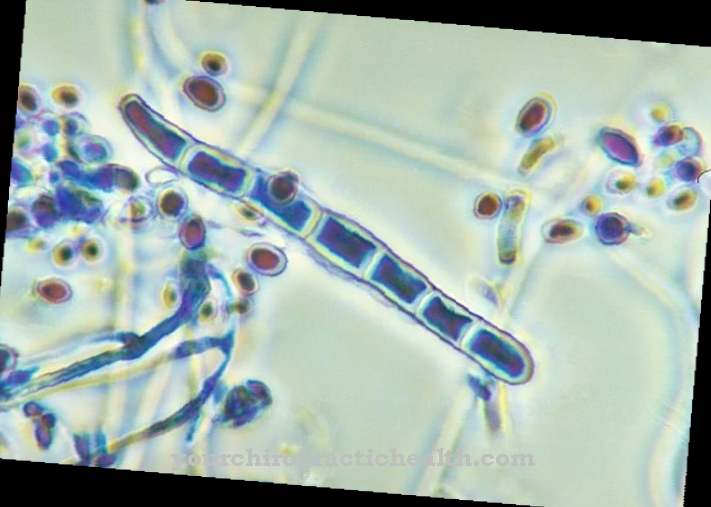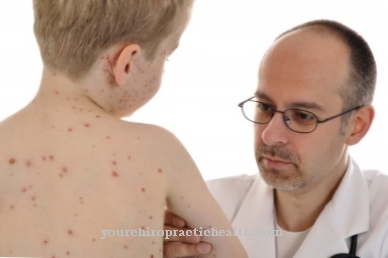The virus Orthopoxvirus variola is the cause of smallpox, a dangerous infectious disease that has probably been around for thousands of years. The name smallpox means bladder or pocket and refers to the lesions on the skin that are one of the most obvious symptoms of this disease.
What is orthopoxvirus variola?
The humane one Smallpox virus (Orthopoxvirus variola) was probably detected for the first time around 1906 by the Mexican-German vaccination doctor Enrique Paschen. With the help of a light microscope, he succeeded in discovering the so-called elementary bodies in the lymphatic fluid of an infected child, which were named after him as Paschen's bodies.
However, the ancient Egyptians already knew about this disease. They called it Uhedu Disease. In ancient China, at the time of the construction of the Great Wall, they spoke of hunpox and the ancient Romans called smallpox the Antonine plague.
In addition to the real smallpox (variola major or variola vera) there is also the white smallpox (variola minor) and the East African smallpox, also known as black pox. In addition to these human pox viruses, there are also various animal pox viruses such as monkey pox, cow pox and camel pox, which can also be transmitted to humans via the relevant intermediate hosts.
Occurrence, Distribution & Properties
Smallpox has repeatedly caused devastating epidemics in the past, killing millions of people. They were considered one of the biblical plagues, raged in the Roman Empire for decades, exterminated parts of the native peoples of America, Africa and Australia and probably came to Europe with the Crusaders. At that time, an estimated 400,000 people died here every year as a result of the disease. At times, the number of people suffering from smallpox and deaths even exceeded the number of deaths from the plague or cholera.
Famous personalities of history such as Luis XV, King of France and Navarre or the Russian Tsar Peter II died from it. Beethoven probably became deaf from smallpox, and Josef Haydn's face was disfigured by smallpox scars.
From the beginning of the 19th century, there were smallpox vaccinations with live vaccines, which made it possible to suppress smallpox quickly. The number of new infections fell. In 1967 the World Health Organization (WHO) began a worldwide campaign to eradicate smallpox, a general compulsory vaccination was introduced, and in 1980 the WHO established that the smallpox virus can practically be considered extinct. As a result, general smallpox vaccinations were abolished. However, in many countries around the world (including Germany) there is still a supply of vaccines for the prevention of possible smallpox outbreaks and for the early treatment of groups of people who may be at risk or infected.
Illnesses & ailments
The last recorded cases of human smallpox were in Bangladesh in 1975, Birmingham in 1978 and Somalia. However, there are still research facilities, at least in the USA and Russia, in which smallpox viruses are stored.
Since the elimination of smallpox vaccinations, the number of people in Africa in particular who contract monkey pox (orthopoxvirus simiae) or cowpox (orthopoxvirus bovis) has increased. So far, these types of smallpox have not occurred in vaccinated people, since a so-called "cross-infection protection" is given. In addition, some researchers fear that animal smallpox species could mutate over time, making it more likely to be transmitted from person to person.
The human smallpox virus can theoretically be transmitted through droplet infection when coughing and sneezing, but also through inhalation of dust from infected bedding, clothing, dishes or other objects with which the sick person has come into contact. Laboratory accidents are also possible.
Monkey pox can be transmitted to humans when infected rodents, rats, or monkeys bite, scratch, or eat the meat of infected animals. Cow and camel pox are sometimes transmitted during milking.
The incubation period for the smallpox viruses is 2 weeks on average. When the disease breaks out, there is a serious feeling of illness. People have a high fever, chills, headaches and aching limbs, sore throats, and swollen lymph nodes. The fever generally runs in two bouts, after the second bout the skin changes typical of smallpox appear. The pustules and skin blisters mainly spread to the face, neck, chest, groin region and feet.
When the smallpox dries up and falls off after weeks, it often leaves skin pitted or pockmarked. In the case of a particularly severe course of the disease, serious consequential damage such as paralysis, brain damage and blindness can also occur. But lighter gradients are also common. The risk of infection with smallpox is very high. Treatment options are limited to strict bed rest, antipyretic and pain relievers, and the treatment of secondary illnesses.
In the past, the majority of people with smallpox died. In the 20th century, the mortality rate was around 30 percent. The disease particularly affects patients with a weakened immune system, the elderly and children. In people infected with animal pox, the mortality rate is significantly lower and is around one percent. Those who survive smallpox are then resistant and thus protected against the disease for a lifetime.
















.jpg)











